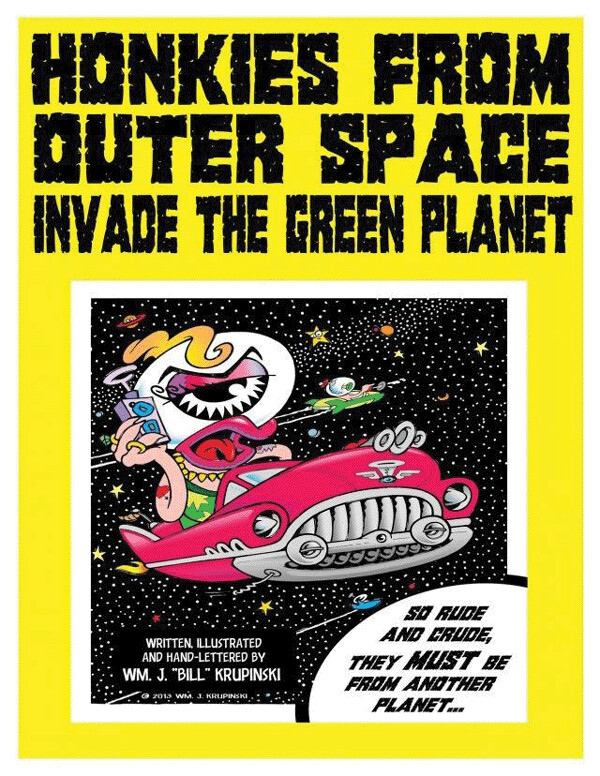HONKIES FROM OUTER SPACE

Released in 2013, this graphic novel is a gem of underground cartooning. “Underground” in the sense that it’s a throwback to the great independent comics of the 1960s and ‘70s: Zap, Bijou, Freak Brothers, etc., noted for their groundbreaking artwork, social satire, cosmic wisdom, smutty humor and general lack of restraint. That’s no coincidence. The author, William J. Krupinksi, has roots in the Milwaukee underground comics scene, home of Kitchen Sink Press.
The title sounds like a satire on race, given that “honkies” is a dated (circa 1970s) term for white people. Here it’s mostly a pun. Residents of the green planet dub the invaders from the planet Girth “honkies” because the latter drive around in flying convertibles and honk little horns that double as zap guns. “Our honking of horns is the pronouncement of our rightful ownership of all that we come upon,” says one of the Girthlings, which could describe humanity in general.
The Girthlings’ heads are giant eyeballs with lips and various cheesy hairdos attached. Having overpopulated their home (“Mass genocides could not keep up wit’ th’ mandatory birth rate”) they seek out other planets to strip of resources, like the aliens of “Independence Day” only tackier. They’re also partial to rap music, though they’re terrible at it. (“We are the Girthlings / Gonna take all yer things / Yo! Yo! Gimme gimme gimme …”)
The green planet is occupied by four intelligent species that live in harmony: the elf-like Verdea; the turtle-like Shelltic, who care for the water; the wormy Gnurms who oversee plants and soil; and the eagle-like Candors, protectors of the air. The female protagonist, Swampy Bokay, lives blissfully in the backwaters, though her boyfriend is an urbane newspaper reporter, Akamon Yawl. Together they investigate the source of mysterious electrical storms that are wreaking havoc worldwide, which they trace to the “honkies.”
The author was inspired by going to a Wisconsin family campground in search of quiet introspection (bad idea) and witnessing the invasion of screaming families in honking vehicles. In the afterword he writes, “Revelry reached fever pitch after the sun set, the alcohol flowed, and the stadium-quality stereos blared their raucous rock late into the night. This, then, was how the ‘American Family’ relaxed in nature.”
Actually that sounds kind of fun, which the author is not against, though he’s all for nature. Festivities, feasts and concerts make up the book’s best passages. A singer’s voice “evokes the release of 1,000 joyous orgasms tempered by 1,000 broken hearts. Eternity swings wide its doors as the night makes its grand procession, arm in arm with its beloved sister, the moon.”
Basically the Verdeans are hippies, if not exactly pacifists or vegetarians; the book opens with a rather brutal description of “noodling,” catching fish by jamming one’s hand into their mouths. Being hippies they’re slow to respond to the invasion, as no global crisis can interfere with the full moon celebration, the Council of Elders ceremonies or the urge to idly enjoy life.
When they do confront the threat, they overcome not through warfare but their wits and, oddly enough, music. Sex is also involved as a Verdean seduces the Girthling queen with a good spanking by frying pan. The story is a fable about the power of forgiveness, which the Verdeans deal out with relative ease, unthinkable as it might seem to us humans.
At times there’s too much novel and not enough graphic, with long blocks of text detailing needless exposition. A proofreader might have pointed out that “lightning” is not spelled “lightening” and that “its” possessive does not have an apostrophe.
The black and white artwork, with its bold lines, resembles a cross between Skip Williamson and ancient Inca paintings. It’s not sold as an adult coloring book but would make a perfect one, as the pages look invitingly like they want to be filled in.
The story takes up only half the book. The other half consists of 52 full-page drawings, each marked “suitable for framing” on the back. Many of the characters on the cards barely register in the story, which I would like to have seen more of. Only the most rabid fans would frame all those pictures, but it could happen. Especially if they color them in.
“Honkies” is available for $25 by emailing kruptoonsink@gmail.com and $9.99 for Kindle. See also kruptoons.com.
